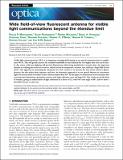Files in this item
Wide field-of-view fluorescent antenna for visible light communications beyond the étendue limit
Item metadata
| dc.contributor.author | Manousiadis, Pavlos | |
| dc.contributor.author | Rajbhandari, Sujan | |
| dc.contributor.author | Mulyawan, Rahmat | |
| dc.contributor.author | Vithanage, Chiranthika Dimali Amarasinghe | |
| dc.contributor.author | Chun, Hyunchae | |
| dc.contributor.author | Faulkner, Grahame | |
| dc.contributor.author | O'Brien, Dominic C | |
| dc.contributor.author | Turnbull, Graham Alexander | |
| dc.contributor.author | Collins, Stephen | |
| dc.contributor.author | Samuel, Ifor David William | |
| dc.date.accessioned | 2016-06-30T10:30:07Z | |
| dc.date.available | 2016-06-30T10:30:07Z | |
| dc.date.issued | 2016-07-20 | |
| dc.identifier | 243157267 | |
| dc.identifier | 050e430a-cd56-49b8-a8b7-c08ea62cd9f9 | |
| dc.identifier | 000381736100007 | |
| dc.identifier | 000381736100007 | |
| dc.identifier | 84978984887 | |
| dc.identifier.citation | Manousiadis , P , Rajbhandari , S , Mulyawan , R , Vithanage , C D A , Chun , H , Faulkner , G , O'Brien , D C , Turnbull , G A , Collins , S & Samuel , I D W 2016 , ' Wide field-of-view fluorescent antenna for visible light communications beyond the étendue limit ' , Optica , vol. 3 , no. 7 , pp. 702-706 . https://doi.org/10.1364/OPTICA.3.000702 | en |
| dc.identifier.issn | 2334-2536 | |
| dc.identifier.other | ORCID: /0000-0002-2132-7091/work/31037444 | |
| dc.identifier.other | ORCID: /0000-0001-8678-9126/work/47136523 | |
| dc.identifier.other | ORCID: /0000-0001-6457-3236/work/60427392 | |
| dc.identifier.uri | https://hdl.handle.net/10023/9065 | |
| dc.description | Engineering and Physical Sciences Research Council (EPSRC) (EP/I00243X, EP/K00042X/1, EP/K008757/1). IDWS also acknowledges support from the European Research Council (grand 321305) and a Royal Society Wolfson Research Merit Award. | en |
| dc.description.abstract | Visible light communications (VLC) is an important emerging field aiming to use optical communications to supplement Wi-Fi. This will greatly increase the available bandwidth so that demands for ever-higher data rates can be met. In this vision, solid-state lighting will provide illumination while being modulated to transmit data. An important obstacle to realizing this vision are receivers, which need to be inexpensive, sensitive, fast, and have a large field of view (FoV). One approach to increasing the sensitivity of a VLC receiver is to increase the area of the receiver’s photodetector, but this makes them expensive and slow. An alternative approach is to use optical elements to concentrate light, but conservation of étendue in these elements limits their FoV. In this paper, we demonstrate novel antennas that overcome these limitations, giving fast receivers with large collection areas and large FoV. Our results exceed the limit of étendue, giving an enhancement of light collection by a factor of 12, with FoV semi-angle of 60°, and we show a threefold increase in data rate. | |
| dc.format.extent | 5 | |
| dc.format.extent | 1184804 | |
| dc.language.iso | eng | |
| dc.relation.ispartof | Optica | en |
| dc.subject | Visible light communications | en |
| dc.subject | Organic materials | en |
| dc.subject | Optical devices | en |
| dc.subject | Non-imaging optics | en |
| dc.subject | QB Astronomy | en |
| dc.subject | QC Physics | en |
| dc.subject | NDAS | en |
| dc.subject | BDC | en |
| dc.subject | R2C | en |
| dc.subject.lcc | QB | en |
| dc.subject.lcc | QC | en |
| dc.title | Wide field-of-view fluorescent antenna for visible light communications beyond the étendue limit | en |
| dc.type | Journal article | en |
| dc.contributor.sponsor | EPSRC | en |
| dc.contributor.sponsor | EPSRC | en |
| dc.contributor.sponsor | European Research Council | en |
| dc.contributor.institution | University of St Andrews. School of Physics and Astronomy | en |
| dc.contributor.institution | University of St Andrews. Condensed Matter Physics | en |
| dc.identifier.doi | https://doi.org/10.1364/OPTICA.3.000702 | |
| dc.description.status | Peer reviewed | en |
| dc.identifier.url | https://doi.org/10.1364/OPTICA.3.000702.s001 | en |
| dc.identifier.grantnumber | EP/I00243X/1 | en |
| dc.identifier.grantnumber | EP/K00042X/1 | en |
| dc.identifier.grantnumber | en |
This item appears in the following Collection(s)
Items in the St Andrews Research Repository are protected by copyright, with all rights reserved, unless otherwise indicated.

